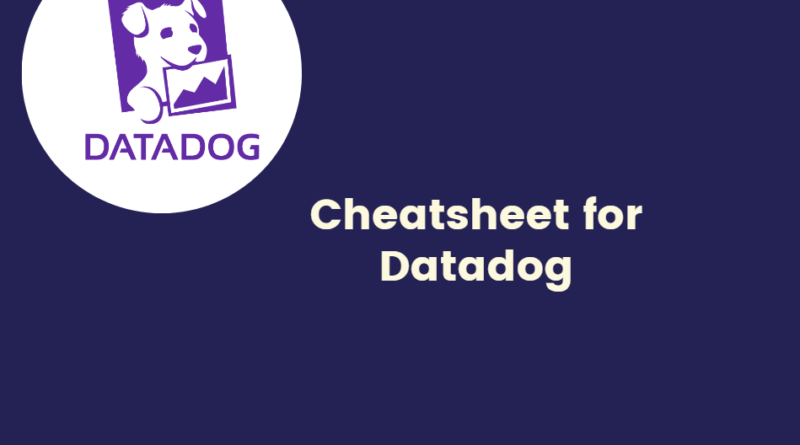Cheatsheet for Datadog monitoring tool
Metrics
To send a metric to Datadog using Python:
import datadog
import time
datadog.initialize(api_key='YOUR_API_KEY_HERE')
while True:
datadog.api.Metric.send(metric='myapp.requests.count', points=1)
time.sleep(1)
To send a metric to Datadog using Bash:
#!/bin/bash
API_KEY="YOUR_API_KEY_HERE"
APP_KEY="YOUR_APP_KEY_HERE"
METRIC_NAME="myapp.requests.count"
METRIC_VALUE=1
curl -X POST -H "Content-type: application/json" \
-d "{\"series\" :
[{\"metric\":\"$METRIC_NAME\",
\"points\":[[$(date +%s),$METRIC_VALUE]],
\"type\":\"gauge\",
\"host\":\"$(hostname)\",
\"tags\":[\"environment:production\"]}
]
}" \
"https://api.datadoghq.com/api/v1/series?api_key=$API_KEY&application_key=$APP_KEY"
Tags
To send a metric with tags to Datadog using Python:
import datadog
import time
datadog.initialize(api_key='YOUR_API_KEY_HERE')
while True:
datadog.api.Metric.send(metric='myapp.requests.count', points=1, tags=['environment:production', 'app:myapp'])
time.sleep(1)
To send a metric with tags to Datadog using Bash:
#!/bin/bash
API_KEY="YOUR_API_KEY_HERE"
APP_KEY="YOUR_APP_KEY_HERE"
METRIC_NAME="myapp.requests.count"
METRIC_VALUE=1
curl -X POST -H "Content-type: application/json" \
-d "{\"series\" :
[{\"metric\":\"$METRIC_NAME\",
\"points\":[[$(date +%s),$METRIC_VALUE]],
\"type\":\"gauge\",
\"host\":\"$(hostname)\",
\"tags\":[\"environment:production\",\"app:myapp\"]}
]
}" \
"https://api.datadoghq.com/api/v1/series?api_key=$API_KEY&application_key=$APP_KEY"
Dashboards
To create a dashboard in Datadog using JSON:
{
"title": "My Dashboard",
"description": "This is my dashboard",
"graphs": [
{
"title": "Requests per second",
"definition": {
"requests": [
{
"q": "avg:myapp.requests.count{environment:production} by {app}.rollup(avg, 60)",
"type": "line",
"style": {
"palette": "dog_classic",
"line_type": "solid",
"line_width": "normal",
"line_interpolation": "linear"
},
"conditional_formats": []
}
],
"viz": "timeseries",
"autoscale": true
}
}
]
}
To create a dashboard in Datadog using the web UI:
- Navigate to the Dashboards page in the Datadog web UI.
- Click the “New Dashboard” button.
- Configure your dashboard by adding graphs and widgets using the visual editor.
- Save your dashboard.
Alerts
To create an alert in Datadog using the web UI:
- Navigate to the Monitors page in the Datadog web UI.
- Click the “New Monitor” button.
- Configure your monitor by selecting the metric or event you want to monitor, and setting the alert
- thresholds and notification settings.
- 4. Save your monitor.
To create an alert in Datadog using JSON:
{
"name": "My Alert",
"query": "avg:myapp.requests.count{environment:production} by {app} > 10",
"message": "Requests per second for {{#is_alert}}ALERT{{/is_alert}}{{#is_warning}}WARNING{{/is_warning}}: {{value}}",
"tags": ["environment:production", "app:myapp"],
"options": {
"notify_no_data": true,
"no_data_timeframe": 10,
"timeout_h": 1,
"evaluation_delay": 5,
"escalation_message": "Alert escalated to level 2"
}
}
To create an alert using Python:
import datadog
datadog.initialize(api_key='YOUR_API_KEY_HERE')
options = {
'notify_no_data': True,
'no_data_timeframe': 10,
'timeout_h': 1,
'evaluation_delay': 5,
'escalation_message': 'Alert escalated to level 2'
}
query = 'avg:myapp.requests.count{environment:production} by {app} > 10'
alert = datadog.api.Monitor.create(
type='metric alert',
query=query,
name='My Alert',
message='Requests per second for {{#is_alert}}ALERT{{/is_alert}}{{#is_warning}}WARNING{{/is_warning}}: {{value}}',
tags=['environment:production', 'app:myapp'],
options=options
)
Logs
To send a log to Datadog using Python:
import datadog
datadog.initialize(api_key='YOUR_API_KEY_HERE')
datadog.api.Event.create(title='Log message', text='This is my log message', tags=['environment:production', 'app:myapp'])
To send a log to Datadog using Bash:
#!/bin/bash
API_KEY="YOUR_API_KEY_HERE"
APP_KEY="YOUR_APP_KEY_HERE"
TITLE="Log message"
TEXT="This is my log message"
TAGS="environment:production,app:myapp"
curl -X POST -H "Content-type: application/json" \
-d "{\"title\":\"$TITLE\",
\"text\":\"$TEXT\",
\"tags\":\"$TAGS\"
}" \
"https://api.datadoghq.com/api/v1/events?api_key=$API_KEY&application_key=$APP_KEY"




